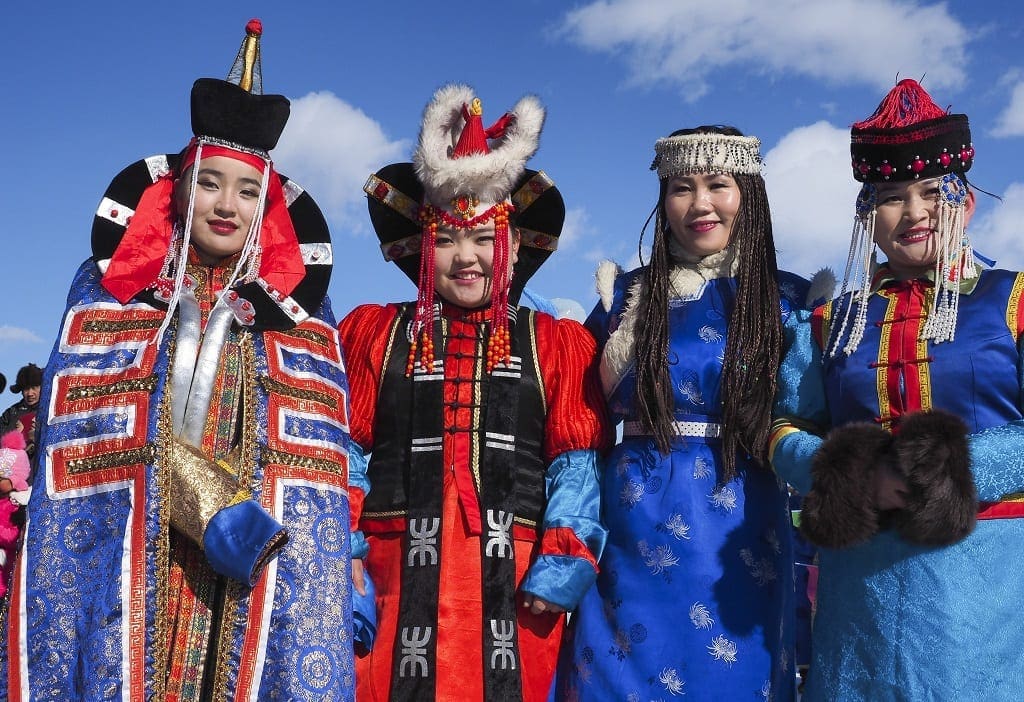From horse-drawn sledges on a frozen lake to the world’s biggest camel race in the Gobi desert, Travel Begins at 40 has selected five great Mongolia festivals for 2020.
Tsagaan Sar: 25 – 27 January
We start with the most important of Mongolia festivals, Tsagaan Sar or Mongolian New Year in the heart of winter and celebrated all over the country. Despite extreme sub-zero temperatures at this time of the year, Tsagaan Sar is a great occasion to discover Mongolia when local traditions come to life through age-old rituals and the proud display of the locals’ colourful deel or traditional costumes.
This is also the best occasion of the year to serve national culinary delicacies to guests, such as buuz or meat-filled dumplings, traditional sweets called shiniin idee, and of course plenty of vodka – so don’t visit with a full stomach.
Expect the week after Tsagaan Sar to be buzzing with activity as this is when people travel all over the country to pay respects to family and friends with lots of exchanging of gifts and traditional greetings or zolgokh. The colour, food and hospitality of Tsagaan Sar will be a rich reward for your braving of the subarctic cold.
Khövsgöl Ice Festival: 28 Feb. – 1 March
For the ultimate Mongolian winter fun experience, the country’s Ice Festival is probably as good as it gets. The enormous Khövsgöl Lake, which is located near the border with Siberia, is Mongolia’s largest body of freshwater and turns every year into a vast playground when it freezes over completely. Here you can admire elaborate ice sculptures – or create your own – and be a spectator of traditional Mongolian competitive sports such as tug of war on ice, dog sledding, sumo wrestling and racing with horse-drawn sledges over long distances.
Khövsgöl’s Ice Festival is also a great opportunity to sample typical Mongolian cuisine and admire the traditional costumes from the country’s 21 different aimags or regions who participate in the event. For photographers, the intricate patterns revealed through the clear surface of the dark blue ice make for stunning photography while the magnificent backdrop of the snow-covered hilltops does the rest.
Winter Golden Eagle Festival: 3 – 4 March
Mongolia’s Golden Eagle Festival originates from its only Kazakh-majority province in the remote west of the country where it was first organised to help raise interest again with younger generations in the traditional hunter culture of ethnic Kazakhs. However, since recent years travellers can now more easily experience this remarkable display of falconry and ethnic-Kazakh culture nearby Mongolia’s capital Ulaanbaatar.
After the award-nominated 2016 documentary The Eagle Huntress came out, the Winter Eagle Festival has attracted an increasing number of local and foreign visitors who come to admire the breathtaking speed and agility of the trained hunting eagles, as well as the imposing traditional attire of their masters. Additional cultural displays include Kazakh music and dance, competitive horse and camel races, and handicrafts while prizes are awarded for fastest eagle, best trainer, most beautiful costume and other things. This is yet another one of Mongolia festivals where bringing your camera is essential.
Temeenii Bayar or Camel Festival: 6 – 7 March
Temeenii Bayar, or Mongolia’s Camel Festival, takes place in the Gobi desert only a few days after the Winter Golden Eagle and Khövsgöl Ice festivals – so with a bit of advance planning you can catch all three Mongolia festivals in one trip. Billed as the world’s biggest camel race, this festive event is all about celebrating the nomadic herders’ most important animal – the local Bactrian Camel.
Apart from the enormous and popular camel race, expect camel-related sports and activities such as camel polo and beauty contests where the camels bedecked in colourful attire are paraded in front of the crowds. Other highlights include performances by local dancers and musicians, and as with other Mongolia festivals, local food and drink are omnipresent.
Similarly to the Golden Eagle Festival, the original aim of Temeenii Bayar was to pass on the Mongolian tradition of raising camels to a younger generation and protect the Bactrian Camel population from decline. Nowadays the festival attracts thousands of local and international spectators.
Naadam Festival: 11 – 15 July
Inscribed by Unesco on its list of Intangible Cultural Heritage, the Naadam Festival is Mongolia’s biggest event and celebrated all over the country. With its spectacular displays of nomadic sports, the Naadam Festival – which dates back all the way to the 11th century when Genghis Khan first organised them to train his soldiers – is also often dubbed the nomads’ Olympic Games.
Central to the festival are the Eriin Gurvan Naadam or the ‘three manly games’ of archery, horse racing and Mongolian wrestling, although nowadays only the wrestling competitions remain men-only. Alongside the sporting competitions are many other cultural activities such as grand opening and closing ceremonies, colourful parades, music, fairs and, of course, lots of traditional Mongolian cuisine.
While the most impressive celebrations happen in Mongolia’s capital Ulaanbaatar, the Naadam Festival takes place in every part of the country including small villages where the experience is often a more intimate one. Marking the declaration of Mongolia’s independence from China, the three days of the Naadam Festival are the most important holidays for Mongolians.
Why not take advantage of our special readers offer on a trip to Mongolia to coincide with the Naadam Festival.
Mongolia hotels
To find the best deals on Mongolia hotels and flights to Ulaanbaatar, search via our comparison engine which scans all the major booking sites for the best deals:
Click to search for hotels with AgodaAlternatively, add even more adventure and fun into your trip by travelling more eco-friendly by train. The Trans-Siberian Railway will ride you all the way from Europe to Mongolia.
For more information on Mongolia travel
Check out the Government of Mongolia tourism website.
Cover image: Mongolian women in traditional attire during the opening ceremony of the Khövsgöl Ice Festival. Photo credit: Alain Loss.

